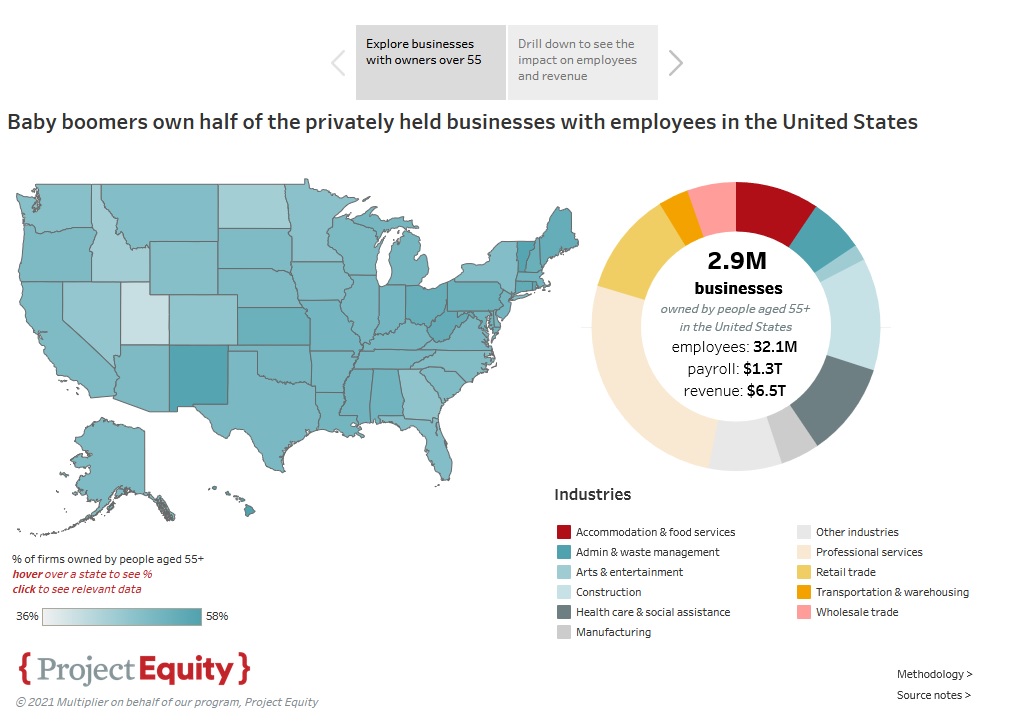- The United States is getting older. By 2035, 76 million Americans will be aged 65 or above. That’s up from 58 million in 2022.
- This “Silver Tsunami” represents a high stakes moment for financial and wealth advisors. Waves of retirees will put the tenets of careful planning to the test. But this demographic shift also threatens to disrupt every aspect of society.
- Take, for example, closely-held businesses. The number of owners at full retirement age rose 87% between 2000 and 2020. This trend continues to accelerate, and its social and economic impact could be profound.
Americans over 55 own half of all US businesses.
These 2.9 million companies – ranging from mom-and-pop outfits to middle market firms – account for 32 million employees, according to Project Equity. Combined, they take home $1.3 trillion in wages and generate roughly $6.5 trillion in revenue each year.

With that many livelihoods on the line, a mass shake-up of closely-held companies could reverberate through the economy. When private businesses leave a community, or fail altogether, locals typically struggle to find equivalent work and local governments lose reliable sources of tax revenue. Mounting waves of retirees falling off payrolls will only compound this issue.
Academics Erika James and Lynn Perry Wooten describe this as a “smoldering crisis.” Job losses, associated wage compression, and an aging population will gradually increase social welfare dependency. Despite a need for additional government resources, diminished income tax revenues will likely erode the social safety net and put added pressure on for-profit service providers. That could send nationwide living standards spiraling downward.
Orderly business transitions could blunt the Silver Tsunami’s impact.
Unfortunately, rigorous succession planning isn’t a common practice among many closely-held businesses. According to a recent survey, 67% of lower middle market owners who put their businesses up for sale in 2022 did so without solidifying a formal exit plan in the year prior.
The absence of a plan increases an owner’s risk of subpar transaction pricing, selling under duress, or struggling to find a buyer at all. Generational succession used to be a backstop in these situations, and it was often a preferred strategy. That’s also become thing of the past.
Millions of working-class Americans are relying on aging business owners to craft thoughtful exit and succession plans. Soaring interest rates and shifting market conditions, though, make sensible, stable paths harder to find.
Some owners have found safe harbor in an underutilized strategy.
Employee stock ownership plans were formalized as part of ERISA in 1974. A legislative “cousin” of the 401(k), ESOPs are often pigeon-holed as benefits programs. While these plans offer retirement incentives to nearly 14 million employee-owners nationwide, ESOPs can also function as M&A alternatives.
Unique among defined contribution plans, ESOPs offer participants stock in a sponsoring company, rather than a third-party entity. A sponsor can contribute shares directly to an employee stock ownership trust, but it can also sell equity to a trust at a fair market valuation. Known as a leveraged ESOP, this strategy enables shareholders of closely-held businesses to gradually divest from their companies or execute a complete liquidity event.
Post transaction, an employee-owned company remains in-tact.
Unlike a third-party sale, an ESOP-owned company’s board of directors continues to manage the business. Meanwhile, employees not only keep their jobs, they earn annual stock allocations at no out-of-pocket cost.
Selling shareholders often choose to maintain meaningful roles. Some continue as guiding figures. Others gradually phase out their day-to-day responsibilities and help pass the helm to a next generation of leaders. In many respects, the stability afforded by an ESOP reflects that of a generational transfer – just to a bigger “family.”
Employee stock ownership plans also offer competitive advantages.
ESOP-specific tax deductions enhance corporate cash flow, while the employee stock benefit often bolsters a company’s ability to hire and retain staff. The promise of stock appreciation drives increased productivity. The latter is described as employee-ownership culture, and its competitive impact has been documented and researched for decades.

These benefits cannot be expected to keep a struggling company afloat, and there are also managerial and financial costs associated with maintaining an ESOP. But an already productive business should be better positioned to navigate the Silver Tsunami under an employee ownership model. That could be a boon for both loyal employees and their broader communities.
The relative attainability and flexibility of an ESOP adds to the transaction’s appeal.
Although plan formation has its rigors, there are fewer outside variables than a typical M&A deal. The sponsor company is neither marketing itself to a broad range of potential buyers nor exposing confidential information to potential competitors. Instead, a company negotiates the transaction with a known, albeit independent, entity: an employee trust.
Even when a business lacks a fully articulated succession plan, a partial ESOP sale can create shareholder liquidity while buying precious time to build a formal strategy. That’s because companies have the freedom to engage in subsequent transactions including secondary ESOP sales, stock buybacks, and plan terminations. Even third-party M&A is an option.
Employee ownership isn’t a panacea, but it could help save America’s private businesses.
Companies with less than 500 employees employed more than half of the US private sector labor force as recently as the late 1990’s. That percentage dipped to 46.4% in 2019. By all initial accounts, the Coronavirus pandemic accelerated this trend.
Roughly 35% of small businesses active prior to the pandemic remained closed as of May 2021. Those that stayed afloat were more acutely challenged by price increases, labor shortages, and higher borrowing costs than their larger competitors. Small business sentiment has waned, and local economies have been uniquely impacted.
If the past is prologue, the Silver Tsunami is a credible threat to America’s closely-held business community. Business owners, and their trusted advisors, can still get ahead of the wave, but now is the time for thoughtful planning and new ideas. A fresh look at employee ownership could be a saving grace for private companies and the communities they call home.
Author Bio: Larry Kaplan has built the nation's leading ESOP investment banking practice at CSG Partners.
Since 2000, CSG’s advisors have guided hundreds of middle market companies through the building and financing of leveraged ESOPs. Employee-owned companies nationwide also trust CSG with secondary sales, plan maintenance, and M&A transactions.





